Others
Kargil Vijay Diwas 2025
Honouring 26 Years of Valour and Victory
Posted On:
25 JUL 2025 5:19PM
Introduction
The nation comes together this year to observe the 26th Kargil Vijay Diwas, a day that shines like a beacon of pride in India’s history. It marks the glorious victory of 1999 when our soldiers, braving snow-clad peaks and relentless enemy fire, reclaimed the heights of Kargil with unmatched courage and unwavering resolve. On 26 July, the tricolour once again soared proudly over the rugged mountains of Ladakh, a symbol of sacrifice, valour, and an unbreakable national spirit.
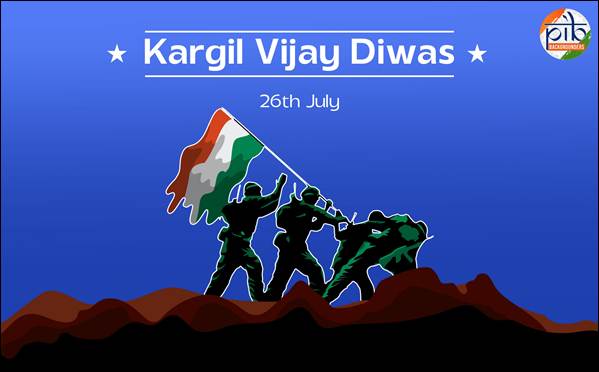
This anniversary is not just a date on the calendar, it is a stirring reminder of the grit and unity that define India. It is a salute to the men who fought in rarefied air and freezing winds, turning every peak into a testament of their bravery.
The conflict that came to be known as the Kargil War began in May 1999 when intruders stealthily crossed the Line of Control and occupied Indian posts on towering ridges. Their sinister aim was to sever National Highway 1A, the vital artery connecting Srinagar to Leh. But they underestimated the will of a nation. India responded with Operation Vijay, a mission that combined meticulous planning, steely determination, and the indomitable spirit of its soldiers. For more than two months, our forces fought inch by inch across the harshest terrain, until every intruder was driven out and every post restored to Indian control.
Kargil Vijay Diwas is more than an occasion of remembrance. It is a pledge to honour the legacy of those who gave everything for the motherland. It is an enduring call to keep alive the spirit of courage and sacrifice that safeguards our freedom. Today, as we pay homage to the heroes of 1999, we reaffirm a timeless truth: India’s unity and sovereignty will forever remain inviolable.
Background: The Kargil War and India’s Response
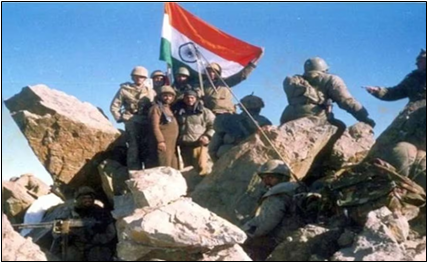
In the summer of 1999, while the rest of India battled the sweltering heat, a different war raged high in the icy Himalayas. It was not a war fought in sprawling deserts or rolling plains but on jagged peaks where oxygen was scarce, temperatures unforgiving, and every inch of ground came at the cost of blood. This was the Kargil War, more than a military operation, it was a test of faith, resilience, and sacrifice.
What began as faint whispers of unusual movement in the high-altitude zones soon turned into an alarming revelation. Indian patrols, trudging through thin air in Batalik, Dras, and Kaksar, stumbled upon intruders entrenched deep within Indian territory. These were no mere insurgents. They were Pakistani soldiers who had scaled icy cliffs during the winter, dug in with weapons and supplies, aiming to sever the vital lifeline connecting Srinagar to Leh. It was a betrayal made starker by the recent Lahore Declaration, a pledge for peace that now lay in tatters.
India’s response was measured but firm. There was no rush for vengeance, only an unwavering determination to restore every inch of violated land. The operation that followed was not about swift manoeuvres across open fields. It was about clawing back peaks, metre by metre, in some of the harshest conditions on earth. Young soldiers, barely in their twenties, strapped rifles across their backs and scaled near vertical cliffs at night, knowing each step exposed them to enemy fire. Every climb was an act of defiance against nature and the adversary.
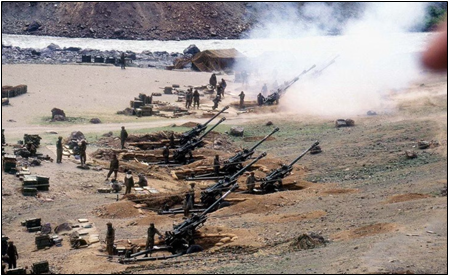
Names like Tololing, Tiger Hill, and Point 4875 became battle cries and symbols of national pride. At Tololing, Major Rajesh Adhikari led his men under relentless fire, refusing to give up despite grave injuries. On Tiger Hill, soldiers scaled near impossible heights in the dead of night to reclaim the peak in a daring assault that changed the tide of the war. At Point 4875, Captain Vikram Batra etched his name in history with his fearless charge and immortal words, “Yeh Dil Maange More,” before laying down his life. Alongside him stood heroes like Captain Anuj Nayyar, Grenadier Yogendra Singh Yadav, Rifleman Sanjay Kumar, and countless others whose courage became India’s shield.
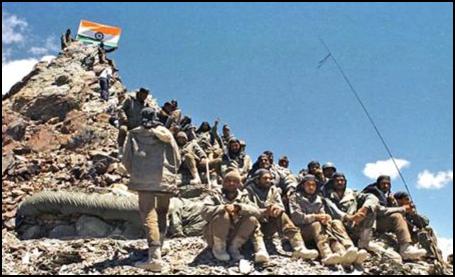
These men endured not just bullets but the wrath of nature, bone-chilling winds, sub-zero temperatures, and oxygen levels that tested endurance at every breath. Yet, their letters home spoke not of fear, but of duty. Some wrote about missing home cooked meals, others promised to return soon, and a few reminded their children to study hard. Many never came back. Their absence was felt in homes where mothers kept lamps burning, where wives clutched photographs, and where children wore their father’s uniform in play, unaware of the permanence of loss.
By late July, after weeks of unrelenting battle, India had reclaimed all occupied posts without crossing the Line of Control. This restraint, even under grave provocation, upheld international law and won India respect across the globe. The cost was steep, 545 soldiers martyred, more than a thousand wounded, but the resolve of the nation only grew stronger. Each name now carved on the walls of the Kargil War Memorial at Dras is a reminder of that price and that pride.
Kargil was more than a military triumph. It was a moment that redefined patriotism. It brought the Indian soldier out of anonymity and into the heart of every citizen. It reminded us that freedom is guarded by those who ask for nothing but the chance to serve. Today, every bugle that sounds at Dras on Kargil Vijay Diwas, every flag that flutters against the barren peaks, carries the echoes of that war, a war that reclaimed not just land, but faith in courage, honour, and the unbreakable bond between a free nation and its defenders.
Heroes of Kargil: Saluting Gallantry
The Kargil War was a story of courage, sacrifice and unwavering determination. Every peak reclaimed was the result of extraordinary acts of bravery. The nation honoured these warriors with its highest military awards.
During the war, 4 soldiers were awarded the Param Vir Chakra (PVC), India’s highest gallantry award. 9 soldiers received the Maha Vir Chakra (MVC) and 55 were honoured with the Vir Chakra (VC). 1 soldier was awarded the Sarvottam Yudh Seva Medal (SYSM), while 6 received the Uttam Yudh Seva Medal (UYSM) and 8 were honoured with the Yudh Seva Medal (YSM). The Sena Medal (SM) was awarded to 83 personnel, and 24 received the Vayu Sena Medal (VSM). These honours reflect the scale of heroism and exceptional service displayed during the conflict.
Grenadier Yogendra Singh Yadav – Param Vir Chakra, 18 Grenadiers
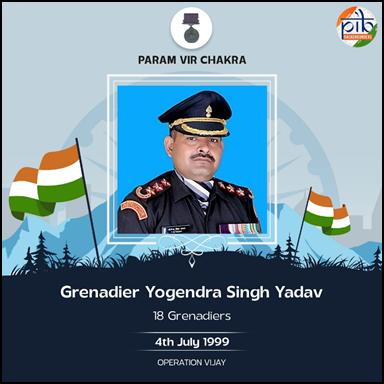
Grenadier Yogendra Singh Yadav was part of the 18th Grenadiers platoon tasked to capture Tiger Hill in Dras. On 3 July 1999, under intense shelling, he began scaling an icy cliff with his team. He destroyed the first enemy bunker, allowing his platoon to climb further. Even after being hit by bullets in the shoulder and abdomen, he pressed on. He destroyed another bunker and killed three enemy soldiers. His courage inspired his comrades to capture Tiger Hill. For this act of exceptional bravery, he was awarded the Param Vir Chakra.
Rifleman Sanjay Kumar – Param Vir Chakra, 13 JAK Rifles
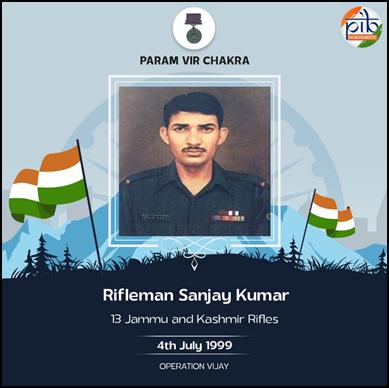
Rifleman Sanjay Kumar of 13 JAK Rifles was among the leading scouts sent to capture a flat-top feature in Mushkoh Valley on 4 July 1999. On reaching the summit, he came under heavy fire from an enemy bunker. He fought a face-to-face battle and killed three intruders, despite being seriously injured. The enemy panicked and abandoned a machine gun. Sanjay Kumar picked up this weapon and turned it on the fleeing soldiers, killing several more. His fearless action inspired his comrades to capture the objective. He received the Param Vir Chakra for his gallantry.
Captain Vikram Batra – Param Vir Chakra (Posthumous), 13 JAK Rifles
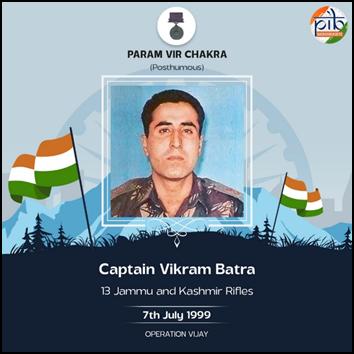
Captain Vikram Batra of 13 JAK Rifles led his troops in the capture of Point 5140. In a daredevil assault, he killed four enemy soldiers in hand-to-hand combat. After the victory, he radioed his success to headquarters with the iconic words, “Yeh Dil Maange More” – a phrase that became a symbol of the spirit of Kargil.
On 7 July 1999, his company was tasked to capture Point 4875. In fierce fighting, he killed five enemy soldiers. Despite being seriously wounded, he continued to lead his men until the mission was complete. He fell in battle after ensuring victory. For his inspiring leadership and supreme sacrifice, he was posthumously awarded the Param Vir Chakra.
Captain Manoj Kumar Pandey – Param Vir Chakra (Posthumous), 11 Gorkha Rifles
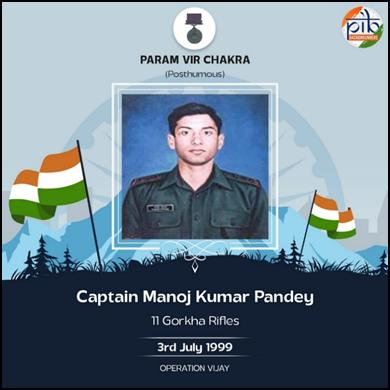
Captain Manoj Kumar Pandey of 11 Gorkha Rifles was ordered to clear Khalubar Ridge in Batalik on 3 July 1999. As his company advanced, they faced heavy enemy fire. He attacked with determination, destroying two enemy bunkers and killing four soldiers. Despite injuries to his shoulder and legs, he pressed on, eliminating more positions. He sustained fatal wounds while leading his men to victory. For his extraordinary courage and sacrifice, he was awarded the Param Vir Chakra posthumously.
Captain Anuj Nayyar - Maha Vir Chakra (Posthumous), 17 Jat
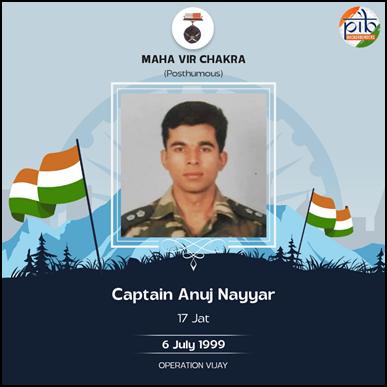
Among the young officers who scaled the peaks of Kargil, Captain Anuj Nayyar was the embodiment of quiet strength. On 6 July 1999, during the assault on Pimple II in the Tololing complex, his company was pinned down by devastating enemy fire. Casualties mounted, and hesitation could have cost lives.
Nayyar assessed the situation, then moved with a resolve that left no room for doubt. Leading from the front, he personally eliminated three enemy bunkers using grenades and close combat skills. As machine gun bursts tore into the rocks around him, he pressed on to destroy a fourth bunker. A rocket-propelled grenade struck him in that final act of defiance, claiming his life in an instant. His bravery broke the enemy’s defensive line, enabling his men to capture the objective. His mother would later recall that he was never one to pick fights, but always one to protect. In Kargil, he lived that truth, shielding his men with his own life.
Major Rajesh Adhikari - Maha Vir Chakra (Posthumous), 18 Grenadiers
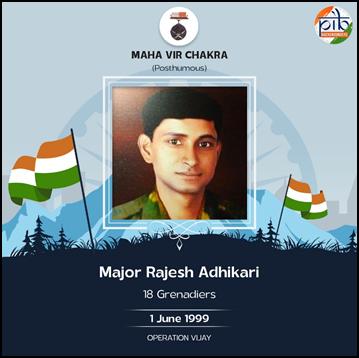
Major Rajesh Adhikari’s story is one of unwavering commitment. On 1 June 1999, during the assault on Tololing, his company faced a barrage of artillery and small arms fire. Progress was slow, casualties heavy.
He moved across open ground in a daring manoeuvre, drawing enemy fire away from his men. With calm precision, he neutralised a key bunker before a burst of enemy fire struck him down. His sacrifice galvanised his troops, who went on to capture the position shortly after.
Lieutenant Keishing Clifford Nongrum - Maha Vir Chakra (Posthumous), 12 JAK LI
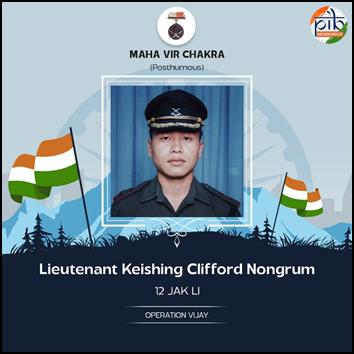
At just 24, Lieutenant Keishing Clifford Nongrum of Meghalaya showed that courage knows no rank or years in service. On the near-vertical slopes of Point 4812 in the Batalik sector, he led his men against entrenched enemy positions.
Pinned down by heavy fire, Clifford surged forward without hesitation. He hurled grenades with unerring accuracy, silencing one bunker after another. Even when injured, he refused evacuation, determined to see the mission through. A bullet in his abdomen ended his life, but not before he inspired his men to storm the peak and claim victory.
His father would later recall Clifford’s words: “If I die, at least it will be as a soldier.” Today, his name is a legend in Shillong and across the North East, a son of the hills whose blood sanctified the snows of Kargil.
Major Vivek Gupta - Maha Vir Chakra (Posthumous), 2 Rajputana Rifles
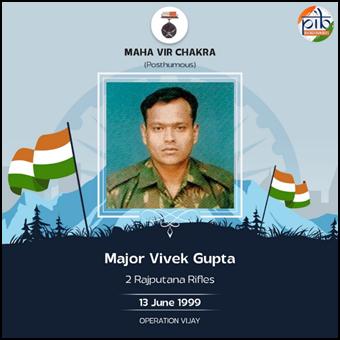
The capture of Tololing was a defining moment in the Kargil War, and Major Vivek Gupta’s leadership made it possible. On 13 June 1999, his company launched an assault under the cover of darkness. The plan was precise, the climb treacherous, and by dawn, they were met with a storm of bullets.
Already wounded, Vivek pressed forward, neutralising a key enemy position that had stalled the advance. Another burst of fire struck him fatally, but not before he created a breach that his troops used to break through and seize the peak.
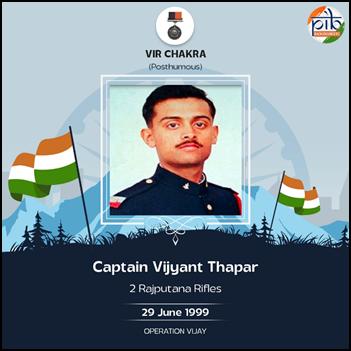
Captain Vijyant Thapar – Vir Chakra (Posthumous), 2 Rajputana Rifles
At just 22, Captain Vijyant Thapar embodied courage and compassion in equal measure. Commissioned into the 2 Rajputana Rifles, he was thrust into the heart of Operation Vijay. In June 1999, his battalion launched an assault on Knoll in the Dras sector, a heavily fortified peak. Leading from the front, Vijyant motivated his men under relentless enemy fire, eliminating multiple bunkers in close combat. Even after sustaining injuries, he pushed forward, only to be struck by a sniper’s bullet just metres from the objective. His actions paved the way for a decisive victory.
What sets his story apart is the letter he left for his family, written with calm acceptance of his fate. “By the time you get this letter, I will be observing you all from the sky. I have no regrets,” he wrote, urging them to live fully and proudly. His words, like his sacrifice, continue to inspire generations and remind us that true heroism is measured not just in battle but in the grace with which one embraces duty and destiny.
Special Initiatives Ahead of the 26th Kargil Vijay Diwas
As the nation prepares to mark the 26th anniversary of Kargil Vijay Diwas, the Indian Army has undertaken a series of initiatives that go beyond ceremonial observance. These events are designed to pay homage to fallen heroes, rekindle the memories of their valour, and strengthen the bond between the Armed Forces and the people. Each effort reflects remembrance, respect, and resolve.
Tribute at Tololing: A Journey of Remembrance
On 11 June 2025, the Indian Army’s Forever in Operations Division organised a commemorative expedition to Tololing Peak, one of the most iconic battlegrounds of the Kargil War. The expedition began from the Kargil War Memorial in Dras and retraced the steps of history to honour the soldiers who recaptured the strategic height during the Battle of Tololing.
A team of 30 soldiers, drawn from units that had fought in the battle, scaled the rugged slopes and hoisted the Tricolour at the summit. Their presence was a living tribute to those who made the ultimate sacrifice. The Indian Air Force joined the effort, with officers and airmen taking part in the climb. This collaboration reflected the spirit of jointmanship that defined Operation Vijay and remains the cornerstone of India’s defence strategy.
This expedition is more than just an adventure, it is a journey of remembrance, reflection and reverence, aimed at inspiring future generations with the stories of courage and sacrifice that shaped the nation's history.
Mountain Terrain Bicycle Expedition: Strength and Outreach
The Indian Army’s Mountain Terrain Bicycle Expedition, conducted by the Forever in Operations Division, commenced from Siachen Base Camp on 25 June 2025 and concluded at the Kargil War Memorial in Dras on 12 July 2025. Covering an arduous 680 km route, the team negotiated some of the world’s toughest mountain passes, including Khardung La, Fotu La and Hambuting La.
Comprising 20 soldiers, this expedition showcased sheer physical endurance and mental strength. It also had a deeper purpose – to engage with local communities and youth. Along the way, the team interacted with 1,100 students from 11 government schools and Ladakh University, narrating stories of the Kargil War and highlighting the immense sacrifices made by our soldiers while protecting the sovereignty of our nation.
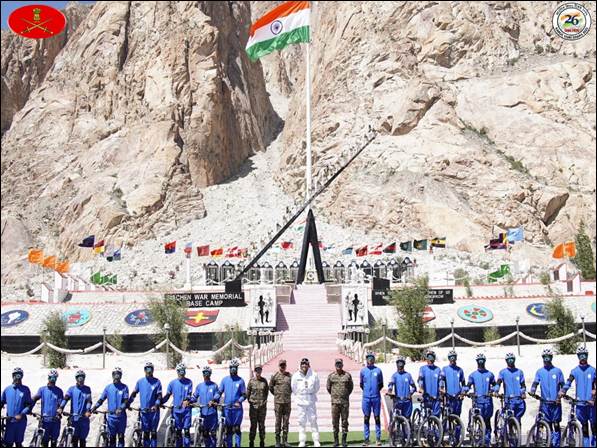
The soldiers also connected with NCC cadets of the 1st and 2nd Ladakh NCC Battalions at Leh and Silmo, underlining the vital role played by the National Cadet Corps in shaping responsible citizens. These sessions motivated young minds to embrace values of discipline and service. The overwhelming support from civilians and Army units en route, who welcomed the cyclists with cheers and refreshments, reflected the enduring trust and respect for the Armed Forces.
Gun Hill Expedition: Honouring the Artillery
On 7 July 2025, the Indian Army undertook a historic expedition to Gun Hill (Point 5140), a strategically significant peak recaptured during the Kargil War. Located in the Dras Sector, Gun Hill is a strategically vital peak recaptured during the 1999 Kargil War, marking a turning point in the conflict. Its capture symbolised the operational brilliance and resolve of the Indian forces.
87 soldiers participated in the expedition, including 20 artillerymen from 10 Artillery Units that had played a pivotal role in the original battle. The peak was officially named “Gun Hill” in 2023 to honour the contribution of artillery regiments in the Kargil War.
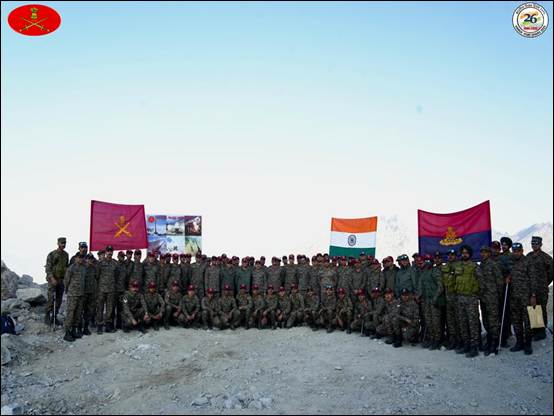
Adding depth to the tribute, veterans who had fought in the sector walked alongside the team. Colonel (then Captain) Rajesh Adhau and Subedar (then Lance Naik) Kewal Singh, Sena Medal, shared first-hand accounts of the battle, instilling pride in the participants. The expedition reinforced the message that the memory of Kargil’s heroes will always be preserved and celebrated.
Special Outreach Drive: Reconnecting with Families of Heroes
In a first-of-its-kind initiative, the Indian Army launched a nationwide outreach drive to honour the families of 545 martyrs of the Kargil War. These include 537 personnel from the Army, five from the Indian Air Force, one from the Border Security Force, and two civilians.
The drive began on 1 June 2025 with 37 outreach teams setting off from Kargil to visit homes of war heroes across 25 states, two union territories and even the Federal Democratic Republic of Nepal. Each visit carried a deep sense of gratitude, as teams presented mementoes, letters of appreciation, and details of government benefits. They also sought to address any concerns faced by the families.
Beyond formalities, the outreach was deeply emotional. Families expressed heartfelt gratitude for being remembered even after 26 years. Many shared how this initiative rekindled memories of their loved ones, while reinforcing their pride in the sacrifices made. The teams also collected memorabilia for display at the Kargil War Memorial, preserving the legacy of the fallen for future generations.
The programme will culminate on 26 July 2025 at the National Commemoration in Dras, attended by dignitaries, serving soldiers, veterans and families of the heroes. This initiative is a living tribute to the unwavering bond between the Armed Forces and the people they serve.
Carrying Forward the Spirit of Kargil
The victory in Kargil was not only a military achievement. It was a message to the world that India will safeguard its sovereignty under all circumstances. This spirit continues to guide the country’s security policy even today. India has moved from a position of prolonged restraint to a clear strategy of decisive action against those who sponsor or support terrorism.
This resolve was evident in Operation SINDOOR, launched on 7 May 2025 in response to the Pahalgam terror attack that claimed 26 innocent lives. The mission showcased a calibrated tri-services response marked by precision, professionalism and purpose. Acting on accurate intelligence, the armed forces targeted nine terrorist camps in Pakistan and Pakistan-occupied Jammu and Kashmir. Advanced drones, loitering munitions and layered air defence systems were deployed to neutralise key threats without crossing international boundaries.
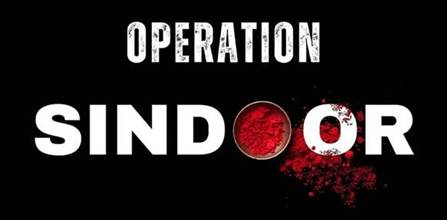
The strikes destroyed key command centres of Jaish-e-Mohammad and Lashkar-e-Taiba and eliminated over 100 terrorists, including those linked to the IC-814 hijacking and the Pulwama attack.
When Pakistan attempted retaliation with drone and missile attacks on 7 and 8 May, India’s integrated air defence network intercepted every threat. This demonstrated the strength of India’s modern net-centric warfare systems and advanced counter-drone capabilities.
Conclusion
Kargil Vijay Diwas is more than a commemoration; it is a sacred reminder of the unyielding courage and supreme sacrifice that brought victory to the nation in 1999. It salutes the heroes who fought against impossible odds on the icy heights of Ladakh, those who gave their today so that India could stand proud and free. Their stories of grit and glory are etched forever in the heart of the nation, inspiring generations to dream, dare, and serve.
The lessons of Kargil transformed India’s approach to security, shaping a stronger, more agile, and self-reliant defence posture. From structural reforms and the creation of the Chief of Defence Staff to the rise of indigenous defence manufacturing and cutting-edge military technology, the nation has marched forward with purpose. Today, India stands confident and battle-ready, its forces equipped with modern capabilities and guided by an unwavering resolve to safeguard every inch of its land.
The spirit of Kargil also resonates in India’s clear and firm response to cross-border terrorism. Surgical Strikes, the Balakot air operations, and the recent Operation SINDOOR have sent an unmistakable message: India desires peace, but it will never hesitate to act decisively when provoked.
As the nation observes the 26th Kargil Vijay Diwas, it renews its pledge to honour the memory of the bravehearts, strengthen its defences and uphold the unity and security of the Republic. Their sacrifice will remain a guiding light for generations to come.
References:
PIB Archives
New India Samachar
PIB Backgrounders
Ministry of Defence:
Click here to see pdf
*****
RT/AKS
(Explainer ID: 154940)
आगंतुक पटल : 12974
Provide suggestions / comments